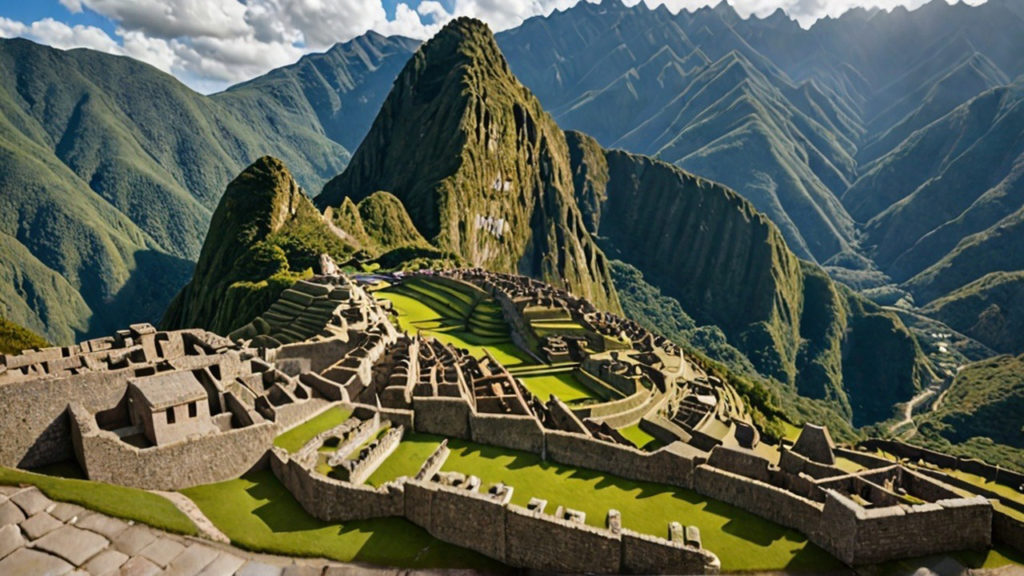Machu Picchu and the Lost Continent of Mu: A Mysterious Connection

Machu Picchu, one of the most enigmatic and awe-inspiring archaeological sites in the world, is often referred to as the “Lost City of the Incas.” Nestled high in the Peruvian Andes, this ancient city continues to captivate historians, archaeologists, and adventure seekers alike. Built by the Inca civilization in the 15th century, its construction and purpose remain the subject of numerous theories. Among these, one particularly intriguing yet speculative hypothesis suggests a possible connection between Machu Picchu and the legendary lost continent of Mu. Could there be a link between this mysterious civilization and the breathtaking ruins of Machu Picchu? While mainstream archaeology largely dismisses such claims, exploring the possibilities of this connection sheds light on both myth and history.
Machu Picchu: The Incan Marvel
Machu Picchu is situated at an elevation of approximately 7,970 feet (2,430 meters) above sea level. Its strategic location, nestled between two prominent peaks, Huayna Picchu and Machu Picchu Mountain, provided both a defensive advantage and an extraordinary view of the surrounding landscape. Constructed by the Inca emperor Pachacuti around 1450 AD, the site is believed to have served multiple functions, including being a royal estate, a religious center, and a ceremonial site.
The architecture of Machu Picchu is nothing short of remarkable. The precision-cut stone walls, terraces, and staircases showcase the advanced engineering skills of the Incas. The site contains over 200 structures, including temples, palaces, and residences, arranged harmoniously with the natural landscape. One of the most intriguing aspects of Incan architecture is their use of the ashlar technique, where stones are cut to fit perfectly without the use of mortar. This method has led to speculation about the origin of their knowledge and whether external influences contributed to their technological prowess.
The Legend of Mu: A Lost Civilization
The lost continent of Mu is a controversial and mythical land said to have existed in the Pacific Ocean. The legend of Mu was popularized in the 19th and early 20th centuries by writers such as Augustus Le Plongeon and James Churchward. According to Churchward, Mu was an advanced civilization that thrived around 50,000 years ago before being swallowed by the ocean due to a catastrophic event. He claimed that evidence of Mu’s influence could be found in ancient cultures around the world, particularly in the architecture, language, and spiritual beliefs of various civilizations, including those in Mesoamerica and South America.
Proponents of the Mu theory argue that survivors of this cataclysmic event migrated to other parts of the world, bringing their knowledge and traditions with them. Some theorists suggest that the Incas, or their predecessors, may have been one such group of migrants, explaining the sophistication of their engineering and architectural achievements.
Connecting Machu Picchu and Mu: Speculative Theories
Architectural Similarities
Supporters of the Mu hypothesis point out that some of the construction techniques used at Machu Picchu resemble those found in other ancient civilizations believed to have connections to Mu. The precise stone-cutting techniques and megalithic structures bear a striking resemblance to sites in the Pacific, such as Nan Madol in Micronesia and even some structures in Easter Island.
The Incas’ ability to move and place massive stones with incredible precision without the use of modern tools remains a mystery. Some theorists suggest that this knowledge may have been inherited from an older civilization, possibly the remnants of Mu.
Linguistic and Mythological Connections
Several indigenous myths in South America speak of a great flood or a sunken land. Some researchers draw parallels between these legends and the story of Mu’s destruction.
Linguistic similarities between Quechua (the language of the Incas) and Polynesian dialects have also been noted, leading some to speculate that there was contact between South America and the Pacific civilizations, possibly stemming from a common origin in Mu.
Advanced Knowledge and Technologies
The Incas demonstrated impressive agricultural, astronomical, and engineering knowledge. Terraces at Machu Picchu showcase an advanced understanding of irrigation and crop cultivation, similar to techniques found in other ancient cultures linked to Mu.
The alignment of key structures at Machu Picchu with celestial bodies suggests a deep understanding of astronomy. Some theorists argue that this knowledge could have been preserved from a much older, lost civilization.
Skeptical Perspectives
Mainstream historians and archaeologists generally dismiss the theory of Mu as pseudo-history. They argue that there is no concrete evidence supporting the existence of a lost continent in the Pacific, let alone its influence on the Inca civilization. Instead, they attribute the Inca’s advanced achievements to their ingenuity, resourcefulness, and long-standing cultural development rather than external influences.
Geological studies do not support the existence of a large landmass that sank beneath the Pacific Ocean in relatively recent history. Additionally, while architectural and linguistic similarities exist between distant cultures, these can often be explained through independent innovation, parallel evolution, or known historical contact rather than a lost ancestral civilization.
Myth, Mystery, and the Enduring Fascination
Machu Picchu remains one of the most extraordinary achievements of human civilization. Whether or not it has any real connection to the lost continent of Mu is a question that likely will never be definitively answered. While the idea of Mu influencing the Inca civilization is largely speculative, it nonetheless highlights the human desire to connect mysterious, ancient sites to larger narratives about lost knowledge and forgotten histories.
The study of Machu Picchu continues to yield insights into the ingenuity of the Inca civilization, reinforcing the idea that indigenous cultures developed sophisticated techniques and knowledge independently. However, the allure of lost civilizations such as Mu ensures that theories of ancient global connections will continue to captivate those who seek to uncover the mysteries of the past. Whether rooted in reality or myth, the connection between Machu Picchu and Mu remains an intriguing possibility that fuels the imagination and inspires exploration into the unknown.
